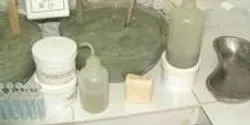soil

In the race to find materials of ever increasing thinness, surface area and conductivity to make better performing battery electrodes, a lump of clay might have just taken the lead. Materials scientists from Drexel University’s College of Engineering invented the clay, which is both highly conductive and can easily be molded into a variety of shapes and sizes. It represents a turn away from the rather complicated and costly processing—currently used to make materials for lithium-ion batteries and supercapacitors—and toward one that looks a bit like rolling out cookie dough with results that are even sweeter from an energy storage standpoint.

Microbes are not only a rich source of disease, but also a rich source of medicines, and experts think many life-saving compounds produced by as-yet-unnamed bacteria are awaiting discovery. But they don’t always give up their secrets easily. Researchers must know where to look to find promising bacteria, and how to get them to grow in the lab, the traditional route to identifying potentially valuable molecules they produce.

Scientists have known for years that together, bacteria and plants can remediate contaminated sites. Ramakrishna Wusirika, of Michigan Technological University, has determined that how you add bacteria to the mix can make a big difference.












